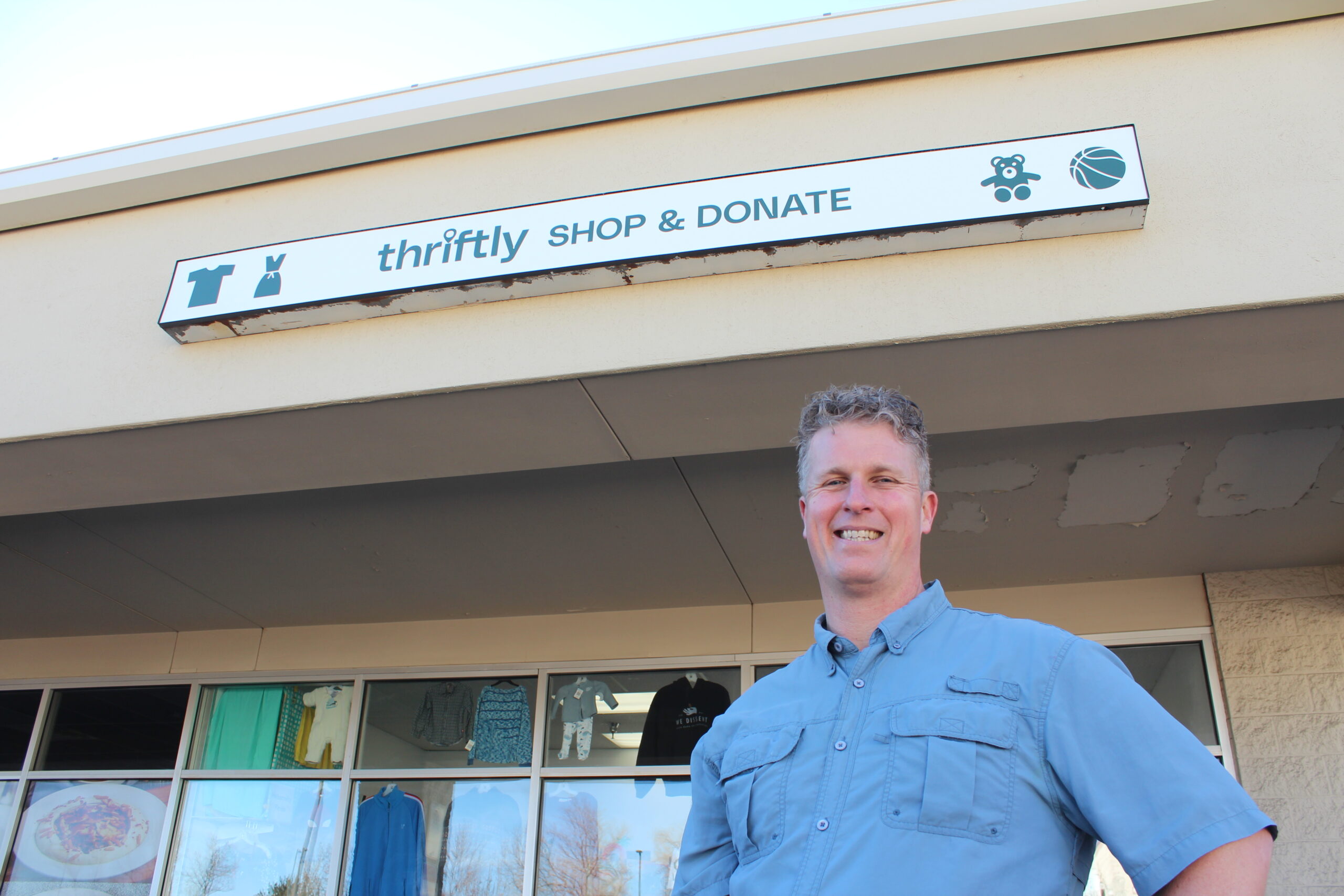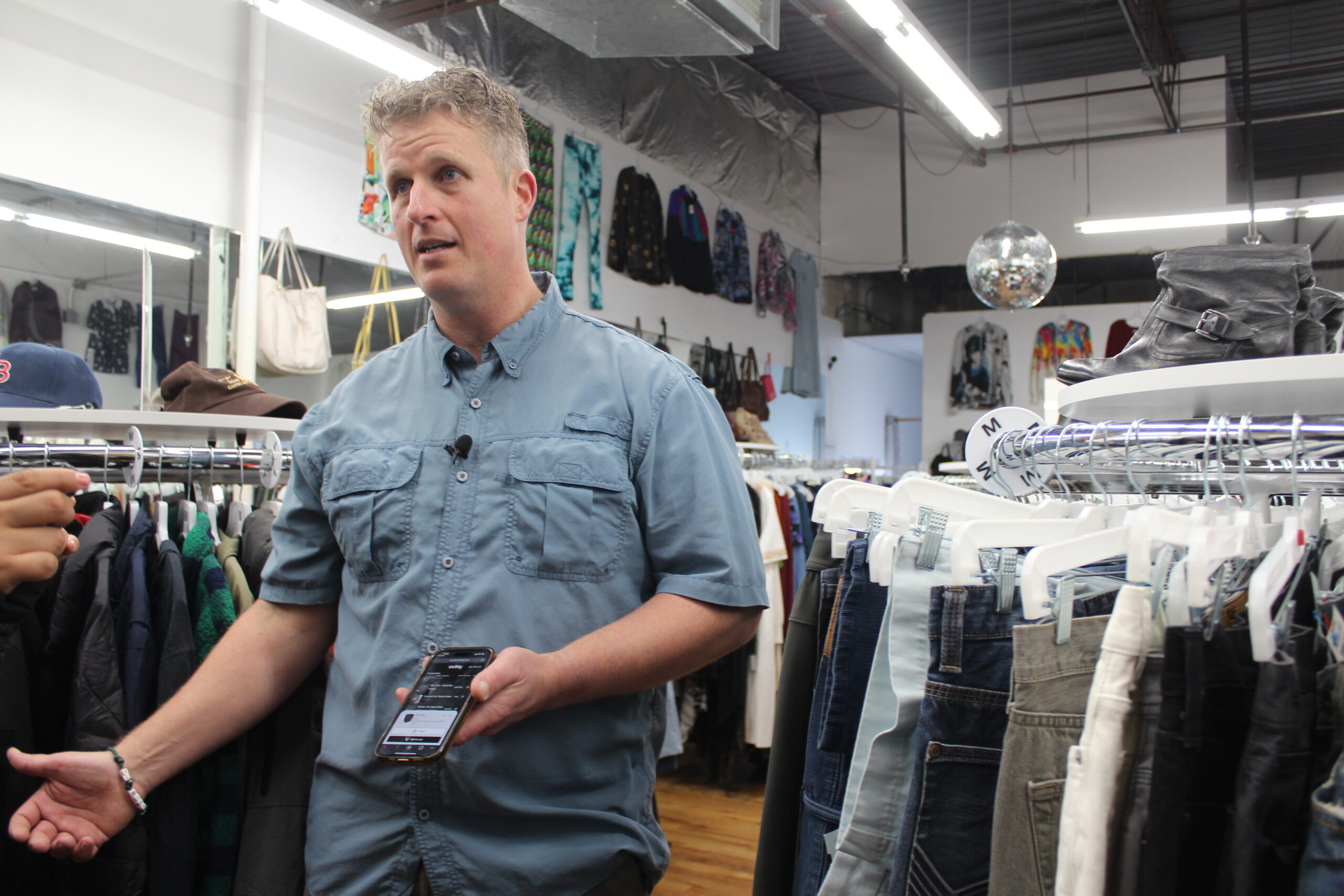
Andy Downard stands in front of Thriftly’s store in southeast Denver. (Max Scheinblum/BusinessDen)
Andy Downard runs a tech startup. And a thrift store in southeast Denver.
The combination is more logical than it might sound, because the company that the 43-year-old founded in 2023 — Thriftly — makes software designed to improve thrift store operations. And the company’s store at 6460 E. Yale Ave. is intended as a testing ground.
“I think that’s an unusual place for startups to function because operations, that physical layer, is so challenging,” he said.
When a BusinessDen reporter visited the store this past Friday, it looked like a typical second-hand shop, offering clothes, books, toys and even a golf club shoe and cleaning kit.
But in true startup fashion, Downard had some trouble getting machines to print and tags to scan.
“This is good,” he said, “because we save all the bugs here so Goodwill won’t have these problems.”
The Louisville, Kentucky, native was the first hire on the product team at Happy Returns, a software and logistics firm that pioneered the online-buy, physical-return process Amazon is known for.
“We did the same thing for the other 60% of e-commerce that isn’t Amazon,” he said.
PayPal bought the company for $275 million in 2021 and sold it to UPS for $465 million.
Downard also founded Los Angeles-based Butterfli, which provides wheelchair-accessible vehicles on demand. He still serves on the board.
But Downard wanted to return to, well, returns. And the in-person thrift business seemed ripe for improvement.
Outside of the rise in Depop and Poshmark — which allowed shoppers to sell thrift items online for a premium — the retail experience hasn’t changed much, he said. Downard, in recovery from alcoholism, also said the mission of many secondhand retailers, mainly Goodwill, was a pull.
“I know what it’s like to really be struggling, and they are giving people second, third, fourth chances out of rehab or jail and are getting them back into the workforce,” he said.

Inside Thriftly’s southeast Denver thrift store. (Max Scheinblum/BusinessDen)
The big area that Thriftly is trying to address is pricing.
“All of thrift for all of time has been employees making their best guess on how to price something,” he said. “They never are getting feedback on if it sold and for how much. The operation is really flying blind.”
Thriftly’s software, meanwhile, takes a picture, prices it using artificial intelligence-sourced web data and prints out a tag in seconds. It can gather data, track inventory and recognize trends, he said.
“We’re just taking some of the thinking out of that and reducing it to a couple taps,” he said. “We’re off-loading cognitive load for them into a machine and introducing consistency of pricing.”
Downard started leasing 1,000 square feet for Thriftly’s Denver store in July. He said it’s helped improve his business.
He’s testing an app on Shopify, a point-of-sales software, that connects with Thriftly’s inventory. When customers scan an item at the register, a picture and description comes up. This solves the problem of tag switching — where shoppers swap out a more expensive price with a cheaper price — that Downard said is prevalent at many stores.
But it’s not all bad news for customers.
Thriftly’s tag has a scannable QR code that pulls up a description on a phone. Currently, bargain hunters just have the option for self-checkout, where they pay on their device and show a receipt on the way out.
But Downard said they will eventually see how the price compares to the item when it’s new or in other used markets, such as eBay.
“We’re trying a bunch of stuff and I’m not sure what’s gonna work,” he said.

Andy Downard shows off the Thriftly QR code scanner inside the company’s southeast Denver thrift store. (Max Scheinblum/BusinessDen)
Downard credits the space for getting the attention of Goodwill, which is piloting Thriftly’s loyalty program software in 62 stores in Florida and the Midwest.
“We have traction. It’s unusual that in the first couple years you’re able to get the attention of the biggest customers that we’re going after,” he said. “But the place where I see us making the biggest splash is in helping with production — the sorting and pricing.”
For now, Thriftly’s software that settles on a price and spits out tags is in use in only two places: at Thriftly’s Denver store and at a store in Brooklyn, New York, that the company doesn’t run. Downard said the latter saw a 13% overnight revenue bump after it began using Thriftly’s tags.
He said Goodwill plans to start using the pricing software in upward of 150 stores.
Downard said Thriftly has revenue, but it’s minimal. Because its software is relatively unproven, he’s offering clients discounted pricing to get it in as many stores as possible.
For the loyalty platform, Thriftly charges a monthly subscription and data collection fee, which scales up as stores collect more contacts. For the pricing software, his company charges a fee per each tag printed. He said he makes a few grand a month in the Thriftly store, $400 from the Goodwill loyalty programs and about $200 from the Brooklyn store.
So far, Thriftly has been self-funded with some help from family and friends. Downard expects to raise institutional capital sometime this year.
“It’s a big market that’s been underserved for decades,” he said. “We really see an opportunity to help thrift capture some of the money that’s currently being left on the table and, in that, help the mission-driven purpose.”

Andy Downard stands in front of Thriftly’s store in southeast Denver. (Max Scheinblum/BusinessDen)
Andy Downard runs a tech startup. And a thrift store in southeast Denver.
The combination is more logical than it might sound, because the company that the 43-year-old founded in 2023 — Thriftly — makes software designed to improve thrift store operations. And the company’s store at 6460 E. Yale Ave. is intended as a testing ground.
“I think that’s an unusual place for startups to function because operations, that physical layer, is so challenging,” he said.
When a BusinessDen reporter visited the store this past Friday, it looked like a typical second-hand shop, offering clothes, books, toys and even a golf club shoe and cleaning kit.
But in true startup fashion, Downard had some trouble getting machines to print and tags to scan.
“This is good,” he said, “because we save all the bugs here so Goodwill won’t have these problems.”
The Louisville, Kentucky, native was the first hire on the product team at Happy Returns, a software and logistics firm that pioneered the online-buy, physical-return process Amazon is known for.
“We did the same thing for the other 60% of e-commerce that isn’t Amazon,” he said.
PayPal bought the company for $275 million in 2021 and sold it to UPS for $465 million.
Downard also founded Los Angeles-based Butterfli, which provides wheelchair-accessible vehicles on demand. He still serves on the board.
But Downard wanted to return to, well, returns. And the in-person thrift business seemed ripe for improvement.
Outside of the rise in Depop and Poshmark — which allowed shoppers to sell thrift items online for a premium — the retail experience hasn’t changed much, he said. Downard, in recovery from alcoholism, also said the mission of many secondhand retailers, mainly Goodwill, was a pull.
“I know what it’s like to really be struggling, and they are giving people second, third, fourth chances out of rehab or jail and are getting them back into the workforce,” he said.

Inside Thriftly’s southeast Denver thrift store. (Max Scheinblum/BusinessDen)
The big area that Thriftly is trying to address is pricing.
“All of thrift for all of time has been employees making their best guess on how to price something,” he said. “They never are getting feedback on if it sold and for how much. The operation is really flying blind.”
Thriftly’s software, meanwhile, takes a picture, prices it using artificial intelligence-sourced web data and prints out a tag in seconds. It can gather data, track inventory and recognize trends, he said.
“We’re just taking some of the thinking out of that and reducing it to a couple taps,” he said. “We’re off-loading cognitive load for them into a machine and introducing consistency of pricing.”
Downard started leasing 1,000 square feet for Thriftly’s Denver store in July. He said it’s helped improve his business.
He’s testing an app on Shopify, a point-of-sales software, that connects with Thriftly’s inventory. When customers scan an item at the register, a picture and description comes up. This solves the problem of tag switching — where shoppers swap out a more expensive price with a cheaper price — that Downard said is prevalent at many stores.
But it’s not all bad news for customers.
Thriftly’s tag has a scannable QR code that pulls up a description on a phone. Currently, bargain hunters just have the option for self-checkout, where they pay on their device and show a receipt on the way out.
But Downard said they will eventually see how the price compares to the item when it’s new or in other used markets, such as eBay.
“We’re trying a bunch of stuff and I’m not sure what’s gonna work,” he said.

Andy Downard shows off the Thriftly QR code scanner inside the company’s southeast Denver thrift store. (Max Scheinblum/BusinessDen)
Downard credits the space for getting the attention of Goodwill, which is piloting Thriftly’s loyalty program software in 62 stores in Florida and the Midwest.
“We have traction. It’s unusual that in the first couple years you’re able to get the attention of the biggest customers that we’re going after,” he said. “But the place where I see us making the biggest splash is in helping with production — the sorting and pricing.”
For now, Thriftly’s software that settles on a price and spits out tags is in use in only two places: at Thriftly’s Denver store and at a store in Brooklyn, New York, that the company doesn’t run. Downard said the latter saw a 13% overnight revenue bump after it began using Thriftly’s tags.
He said Goodwill plans to start using the pricing software in upward of 150 stores.
Downard said Thriftly has revenue, but it’s minimal. Because its software is relatively unproven, he’s offering clients discounted pricing to get it in as many stores as possible.
For the loyalty platform, Thriftly charges a monthly subscription and data collection fee, which scales up as stores collect more contacts. For the pricing software, his company charges a fee per each tag printed. He said he makes a few grand a month in the Thriftly store, $400 from the Goodwill loyalty programs and about $200 from the Brooklyn store.
So far, Thriftly has been self-funded with some help from family and friends. Downard expects to raise institutional capital sometime this year.
“It’s a big market that’s been underserved for decades,” he said. “We really see an opportunity to help thrift capture some of the money that’s currently being left on the table and, in that, help the mission-driven purpose.”


